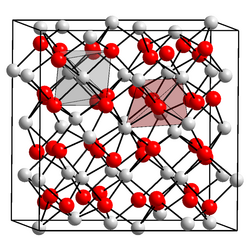 | |
| Names | |
|---|---|
| Other names indium trioxide, indium sesquioxide | |
| Identifiers | |
3D model (JSmol) | |
| ChemSpider | |
| ECHA InfoCard | 100.013.813 |
| EC Number |
|
PubChem CID | |
| UNII | |
CompTox Dashboard (EPA) | |
| |
| |
| Properties | |
| In2O3 | |
| Molar mass | 277.64 g/mol |
| Appearance | yellowish green odorless crystals |
| Density | 7.179 g/cm3 |
| Melting point | 1,910 °C (3,470 °F; 2,180 K) |
| insoluble | |
| Band gap | ~3 eV (300 K) |
| −56.0·10−6 cm3/mol | |
| Structure | |
| Cubic, (Bixbyite) cI80 | |
| Ia3, No. 206 | |
Formula units (Z) | 16 formula per cell |
| Hazards | |
| GHS labelling: [2] | |
  | |
| Danger | |
| H315, H319, H335 | |
| P260, P261, P264, P270, P271, P280, P302+P352, P304+P340, P305+P351+P338, P312, P314, P321, P332+P313, P337+P313, P362, P403+P233, P405, P501 | |
| NFPA 704 (fire diamond) | |
Except where otherwise noted, data are given for materials in their standard state (at 25 °C [77 °F], 100 kPa). | |
Indium(III) oxide (In2 O3) is a chemical compound, an amphoteric oxide of indium.
